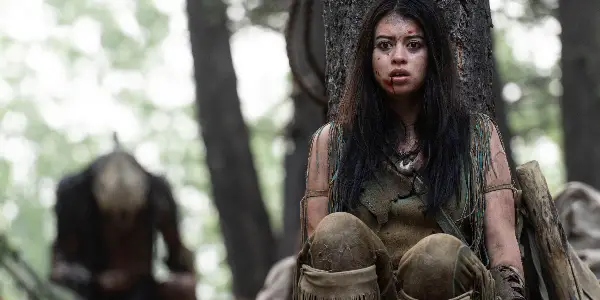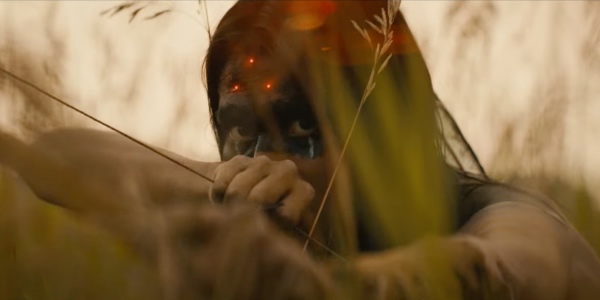PREY: An Anti-Colonialist Action Movie

Brian Walter is a college professor by day and a…
It’s probably the most famous cut in movie history.
The camera tilts up to watch a leg bone spin in slow motion until it reaches its apex against the sky, where it is suddenly, jarringly, replaced by the image of a satellite revolving smoothly in orbit.
The leg bone has just been used to gain the upper hand in a territorial dispute, so the transition from one iconic shot to the other suggests that the key leap forward in human evolution was the discovery that a simple natural object could be turned not just into a kind of tool, but – specifically and ominously – into a weapon.
Human civilization, this pairing of shots implies, is the quest for instruments of power and conquest. We exist to dominate our fellow creatures; worse, we do so by reducing Mother Nature to capital, a vast array of commodities to be exploited by the most inventive, the most aggressive, and the most cunning.
More than half a century after Stanley Kubrick began his science fiction masterpiece 2001: A Space Odyssey (1968) with this pseudo-Darwinian prelude, a relatively unassuming, straight-to-streaming sequel in a long-running science fiction action series has subtly challenged the great director’s grim vision of human nature.
In Dan Trachtenberg’s Prey (2022), the latest entry in the Predator series, the image of human technologies and human possibility is much less simplified than Kubrick’s famous cut would have it – to the film’s great benefit.
Ready to Hunt
Prey tells the story of Naru (Amber Midthunder), a young Comanche woman who is skilled as a healer but yearns to become a hunter like her older brother, Taabe (Dakota Beavers). Early in the film, Naru informs Taabe that she is ready for her kühtaamia, a test to prove her mettle as a hunter. In response, Taabe asks Naru – with mild but unmistakable condescension – if she is ready to hunt something that is also hunting her.
Taabe’s question makes a perfect tagline for the entire Predator series. In six previous installments (counting the two crossovers with the Alien franchise) going back to the original 1987 Arnold Schwarzenegger vehicle, Predator movies have followed the same basic plotline.

A small group of humans gradually becomes aware that they are being stalked by a massive, inhuman extraterrestrial whose camouflaging abilities, thermal vision, and advanced weapons make it almost impossible to vanquish.
The suspense in each film mounts as they try, more and more desperately, to find a way to kill what is picking them off one by one, reducing them all to helpless prey.
Prey manages to refresh this standby formula by making the Predator (or the Yautja, as it has also been known since an early entry in the series) serve as the means of Naru’s kühtaamia as much as she (theoretically) serves as the means of its rite of passage.
To complicate Naru’s test further, the Yautja is not the only interloper in Comanche territory taking lives. In the film’s third act, a band of ruthless French trappers injects itself into the action, and they come up with a plot to use Naru and Taabe to best the otherworldly predator who threatens their colonialist plunder.
Learning from Mistakes
Beset as she is on all sides, Naru faces internal challenges as well. Restless by nature and eager to prove her readiness for adult privileges and responsibilities, Naru makes repeated mistakes before, eventually, she can meet the deadly challenge of the intruders.

A little like Buster Keaton, who would commit blunder after blunder until he could find a way to navigate the climactic series of mental and physical challenges in his films, Naru struggles, misses, often fails, has to be rescued, barely survives, and eventually suffers devastating losses.
And she clearly feels the sting of her failures. Early in the film, she watches unhappily as her brother is celebrated for killing the creature that has just bested her. And that’s not the last time Taabe has to rescue her.
But such failures only feed her resolve. She always learns from her trials, develops new skills and strategies, and emerges by the end as a worthy foe for the extraterrestrial predator who has proven too much for everyone else.
And . . . Action!
Along the way, Trachtenberg treats us to a series of hair-raising confrontations and visceral action sequences, featuring everything from bows, spears, knives, hatchets, and musket loaders to lions, wolves, and grizzly bears. Not content to let the scenic woods and fields of the Northern Plains (a. k. a. British Columbia) feast the eye, Trachtenberg adds a variety of effective touches to the action scenes.
He stages one memorable confrontation in a thick fog that swirls around the hunters and the hunted (like the clouds of smoke in the Valkyrie helicopters scene of Apocalypse Now). In a follow-up battle scene, Trachtenberg unobtrusively drains away the diegetic sound at the crucial moment to heighten the emotional connection with Naru.

The story also tracks Naru’s growth as a strategist who can anticipate the flow of battle and set up resources that will improve her chances of survival. The final confrontation between Naru and the Yautja takes place at night in a clearing that Naru has specially prepared for the encounter. The climactic duel emphasizes the very different ways in which the antagonists perceive the world, raising the symbolic stakes as they square off for the last time.
Working Alone
But if the well-staged, often graphic action sequences should satisfy longtime fans of the series, the lifeblood of the movie pulses through the quieter scenes of Naru’s journey. Usually accompanied only by her faithful dog, Sarii, Naru relies on no one but herself, meeting challenge after challenge with the resources she takes in hand.
The film opens with her being awakened by a kick in the shoulder in the early morning light. Soon, the camera tracks her through the tipis, usually moving opposite or athwart the trajectory of the other members of the village.
The implication is subtle but clear and richly developed through the film: Naru is very much a member of her community, but also a loner, one whose goals might well put her on a different, even opposite path from those closest to her.

Naru’s respectful but defiant relationship with her healer mother is every bit as essential and instructive as her relationship with her accomplished hunter of a brother. In one early scene, Naru points out what is missing in the mixture that her mother is preparing, and she refuses to capitulate when her mother questions her preference for hunting over healing. A knife, she points out, has more than one use.
Restoring the Fourth Wall
The scenes in the Comanche village lend unusual depth to the action sequences in this sequel. In the earlier films, the hunts are largely contrived, an excuse to indulge the kind of military and masculinist braggadocio beloved in big-budget Hollywood action movies.
The first Predator, tellingly, ends with a montage sequence of the principal actors joking and breaking the fourth wall – a favorite touch in ensemble comedies of the 70s and 80s – to signal that all of the killing was done just in good fun.
Such generic winks and nudges are unimaginable in Prey. Naru’s hunt is too personal, the stakes of her kühtaamia too high for the whole tribe (as becomes clear in the final scene). As the principal foe of this film’s Yautja, Naru in fact exposes the curious contrivance of the character, a creature that hunts only for trophies, never for sustenance or self-defense.

The contrast with Naru could not be starker. In early scenes, we see her failing to bring down a deer before finally settling for a smaller rabbit, which she cooks over a fire and shares with Sarii.
But the Yautja unceremoniously strips the skin of its kills, uses a solution to dissolve the pelts, and then straps the suddenly denuded skulls to its gear to wear as emblems of its prowess.
The Yautja’s disrespectful methods unmistakably associate it with the European colonizers, who leave behind evidence of a horribly wasteful slaughter that is discovered by Naru and Sarii. When it comes to taking lives, the Yautja and the Europeans are similarly decadent in their self-serving designs on mere personal profit, not communal survival.
Human (in) Nature
These contrasts inform the film’s subtlest but most resonant philosophical accomplishment. By setting the extraterrestrial predator against a Native woman who hunts and fights not for her own glory but, instead, to feed and protect herself and her people, Prey reinscribes the human into nature.
In this film, humans are not lords of creation striving for supremacy over a powerful rival, but one group of creatures among many who are finding ways to survive against unprecedented dangers. Naru’s survival of the merciless colonialist predators crucially prepares her to survive the merciless otherworldly Predator.
As an additional benefit, Naru serves as a subtle repudiation of the long history of reductive treatments of Native culture in general and of Native women in particular.

From Pocahontas to Tonto, from Tiger Lily to insulting Halloween costumes to the Land of Lakes caricature of a Native woman on her knees hawking dairy products in grocery stores, American pop culture has regularly and outrageously reduced Native women to grotesquely sexualized fantasies for convenience and dangerous, damaging consumption.
But Naru is (to put it mildly) no one’s plaything, and her character implicitly rejects such travesties. Just as importantly, she is not idealized or romanticized. She is headstrong but patient, stubborn but receptive, sometimes naïve but consistently attentive, a student who fails many of her tests but who learns from every situation and every encounter. Her resourcefulness and survival skills are hard-earned and appealing, even heroic.
Less can be More
If Prey does restore the series to bigger budgets and theatrical releases, it will hopefully bring Naru back in as taut and understated a film as Trachtenberg has made. And hopefully, any future theatrical releases will follow Hulu’s example by offering a subtitled Comanche language version along with the English dub. Making the effort to allow Naru and the other Comanche characters to tease, joke with, and confront each other in their mother tongue enhances the film’s anti-colonialist themes.
All of which makes for an unusually vital and satisfying genre movie. With Trachtenberg’s smooth, gliding camera serving as an effective visual proxy, a mostly understated soundtrack (a welcome change from the aural sturm und drang of so many action movies), and an appealingly human story of needful growth and maturation to contextualize its action-driven plotline, Prey offers an excellent example of less being more, especially in a series long known for its over-the-top dialogue and gory violence.
Watch Prey
Does content like this matter to you?
Become a Member and support film journalism. Unlock access to all of Film Inquiry`s great articles. Join a community of like-minded readers who are passionate about cinema - get access to our private members Network, give back to independent filmmakers, and more.
Brian Walter is a college professor by day and a hopelessly sleepy college professor by night. His work has appeared in a variety of literary and film studies publications, and he appears as an 'old coot' interviewer with a magic camera in the final chapter of Donald Harington's final novel, "Enduring." He lives a short walk from the St. Louis Zoo with his remarkably patient, loving wife and a quirky assortment of canine and feline familiars.













